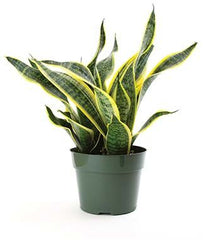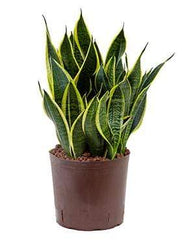How to Grow and Care for Snake Plants
Plant Guide

If houseplant enthusiasts were asked to pick the easiest plants in their collection to grow the answers would be Snake plant. Being one of the easiest plants to care for is not the only reason that snake plants are experiencing resurgence in popularity. They have always been known for having the most interesting foliage, colors, and textures, but more recently, it was discovered that they possess air purifying qualities.
With all the man-made chemical infused products that are used in our homes today, it’s safe to say we could all use a little help removing toxins from our indoor spaces. Snake plants are great for absorbing toxins from the air such as formaldehyde and benzene and releasing oxygen back into the air we breathe according to a NASA study. You’d be surprised how many items in your home contain this potentially harmful chemical.
Snake Plants have one trick that most other house plants do not. Most plants clean the air during the day but snake plants do their work at night while we sleep. This makes them the perfect sleeping companion. Typically our bedrooms are situated to receive less sunlight than other rooms in our home. Sunlight levels are not as important to these wonderful air cleaning machines as some other indoor plants.
Their ability to survive in low light conditions makes them ideal for bedrooms and even bathrooms. Sanseveria planted in pots can be placed in about any room in your home, office or apartment. They even thrive under artificial light. So don't be afraid to put one of these easy to care for plants on your desk.
Ground Rules
Light
As mentioned earlier snake Plants are very tolerant of almost all sunlight conditions. They can take the partial sun on a patio in the warmer months all the way to the artificial light of an office.
Water
Snake Plants prefer to dry out fully between watering. It's a good practice to water a snake plant no more often than every three weeks and some people water the snake plants only once a month. Due to their low water requirements, they make great plants for people on the go or plant lovers that tend to "forget to water".
Place a saucer under the plant to protect your floors from water draining from the pot during watering. It's not a good practice to allow the plant to sit in the excess water as this can cause root rot. you can place a layer of pebbles in the bottom of the saucer which allows for the water to remain in the saucer but holds the plant above the water level.
Soil
Snake Plants or Sanseveria are not too picky when it comes to potting soil. Choose a well-drained potting mix. Look for coarse soil that does not retain too much moisture. Espoma Organic Cactus Mix is our go-to when asked to recommend soil to beginners. It allows excess water to drain so the plant doesn't stay too wet.
Snake Plants that stay too wet tend to develop root rot. Do not plant your plant any deeper than it currently is in its grower pot. this can cause the base of the leaves to develop rot.
Food
Sanseveria is not picky about fertilizer types either. Any balanced fertilizer will do and it is mostly up to you which type and how often you choose to feed the snake plant. There are two different ways to feed indoor plants and either method is effective.
For those that prefer liquid fertilizers, we recommend Jack's Classic All-Purpose Fertilizer. This is mixed with water at the recommended rates. Liquid fertilizers can be mixed at half the recommended rate and used at each watering. If using full rate we recommend using it at every other watering.
Another good choice and the one that is recommended to beginners is Osmocote Plus Indoor and Outdoor fertilizer. This is a timed-release fertilizer that is sprinkled on the soil surface of the plant and provides nutrients each time the plant is watered. This is a good choice for beginners as it is the easiest and safest way to feed plants.
Temperature
Snake Plants do not tolerate colder temperatures below 50 degrees. Be aware of drafts when locating near doors or drafty windows. If you do put your plants outside during the summer be sure to bring them back in as the nighttime temps fall below 55 at night. In the warmer southern areas such as Florida, you will often see sansevieria planted in the landscape.
Planting Process
- Pick out a pot. Choose a pot with a drain hole if possible.
- Pot your snake Plant in a pot no less than two inches bigger than the current pot.
Snake plants multiply and will need the space to produce "pups". Snake plants do not mind being divided so the “pups” can be removed to make new plants.
How do you propagate Snake Plants?
Why Is My Snake Plant Dying?
How Fast Will My Futura Superba Snake Plant Grow?
Types of Snake Plants Available at Garden Goods Direct
| Image | Name | Description |
|---|---|---|
 |
Sansevieria trifasciata laurentii | Often called Golden snake plant has upward-pointing leaves with green-silver striping that add some nice diversity to any houseplant collection. |
 |
Black Coral Snake Plant | Snake Plant Black Coral has silver and green variegated foliage that reaches about 36 inches. |
 |
Snake Plant Superba | Snake Plant Superba has beautifully variegated foliage that reaches a maximum of about 36 inches. Same color as laurentii but with wider leaves. |
 |
Snake Plant Jiboia | Snake Plant Jiboia prefers low light, drought-tolerant houseplant with dark green foliage with wide leaves similar to the Shark Fin Snake Plant that cleans the air of toxins. |
 |
Starfish Snake Plant | Starfish Snake Plant has silvery-green foliage that reaches a maximum of about 10 inches. It stays extremely compact, and growth is near-vertical without branching. Pups, or new “Starfish Arms” appear in the same container as the mother plant and are sent out on runners underground. |
